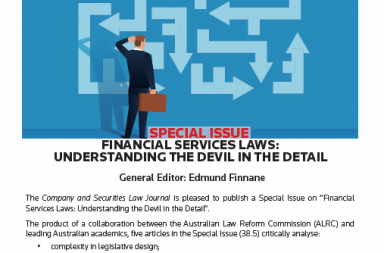*Please note that the links to the content in this Part will direct you to Westlaw AU.
To purchase an article, please email: [email protected] or contact us on 1300 304 195 (Australian customers) or +61 2 8587 7980 (international customers) during business hours (Mon-Fri, 8am-6pm AST).
The latest issue of the Environmental and Planning Law Journal (Volume 38 Part 1) contains the following material:
Articles
Judicial Consideration of Intergenerational Equity in Australian Coal Mine Approval Litigation – Edward Cleary
Proposals to develop large coal mines are often challenged on the basis of their contribution to climate change. An increasing number of these legal challenges cite the climate-related impacts that these projects will have on future generations. Against this backdrop, this article examines four major coal mine approval cases in which the principle of intergenerational equity has been judicially considered: Gray v Minister for Planning, New Acland v Ashman and Chief Executive, Department of Environment and Heritage Protection (No 4), New Acland v Smith, and Gloucester Resources v Minister for Planning. Although these cases have substantially clarified the role and content of the principle of intergenerational equity, they have also exposed uncertainties and obstacles – especially in Queensland – that will need to be overcome before intergenerational equity can assume a more prominent role in Australian coal mine approval litigation.
The Balance of Environmental Protection and Economic Development in Federal Decision-making: An Investigation into Section 74A of the Environment Protection and Biodiversity Conservation Act 1999 (Cth) – Timothy Dickson and Katie Woolaston
Recent use of the split referral process under the Environment Protection and Biodiversity Conservation Act 1999 (Cth) (EPBC Act) in South Australia has raised serious questions around the legitimacy of s 74A and its ability to ensure environmental protection. The referral, assessment and approval process under the EPBC Act purports to limit negative impacts on the environment while facilitating economic development. Section 74A provides the discretionary opportunity to reject a split referral (ie, an application for approval of one aspect of a larger project), however, this research finds the discretion has never been invoked in practice despite identifying suitable opportunities. This article provides critique from an Earth jurisprudence perspective on s 74A and relevant policy with reference to recent decisions, in particular a split referral related to the Olympic Dam development in South Australia. It concludes the current operation of the ministerial power imposes a vague and ambiguous discretion on the Minister which has allowed for the manifestation of pro-development bias in decision-making. Accordingly, the current review of the EPBC Act needs to incorporate reform to either the objects of the EPBC Act or the s 74A power itself to elevate environmental consideration to a primary focus of decision-making processes.
Regulation of Land-based Marine Pollution in Australia: A Critical Assessment of the Current Legal Framework and Opportunities for Reform – Nathan Hegerty
Land-based marine pollution (LBMP), both point source and diffuse, is a significant environmental problem worldwide. Despite the lack of legally binding standards at the international level, Australia has developed quite a comprehensive legal framework for the regulation of LBMP. The nature of federalism in Australia, however, has also resulted in a complex mosaic of Commonwealth, State and Territory laws regulating LBMP. This article provides a critical assessment of the current legal framework for the regulation of LBMP in Australia. In doing so, the article first discusses, the divisions of powers between the Commonwealth and States/Territories as they relate to the regulation of LBMP, the common regulatory approaches used, and the gaps and deficiencies identified within national and State/Territory regulatory frameworks. The article then identifies a number of opportunities for potential legislative reform, including a stronger national framework and amendments to existing State and Territory legislation, which could improve the current LBMP regulatory environment in Australia.
An Inconvenient Covenant: How Climate Risks Are Transforming Australian Superannuation Trustees’ Liability under Statutory Covenants – Olivia Kilponen
Climate change is becoming increasingly recognised as the cause of material financial risks. Assets that are most impacted by these risks are high-carbon and invested over long-term time frames. In Australia, a large number of superannuation funds invest in high-carbon assets over long-term periods. Recent reforms of the Superannuation Industry (Supervision) Act 1993 (Cth) have elevated duties imposed on trustees of superannuation funds. Complementary to the “best interests†duty under s 52(2) of the Act, superannuation trustees are legally required to uphold statutory covenants under s 52(6) and 52(8)(a)(i) that mandate the development of prudential investment strategy and risk management respectively. To successfully uphold these covenants, superannuation trustees must actively adapt their investment strategy and risk management frameworks beyond current industry norms to respond to climate risks. Trustees that fail to do so risk breaching these covenants, which exposes superannuation funds and their trustees to unprecedented legal action.
Legal Rights to Take Water for Managed Aquifer Recharge Projects in Western Australia – Clare Ward-Noonan
“As pressures on water resources increase … new strategies must be developed to supplement natural groundwater resources and increase water availabilityâ€. One such strategy is the implementation of managed aquifer recharge (MAR) projects, defined in the Australian Managed Aquifer Recharge Guidelines as the purposeful recharge of an aquifer using a source of water under controlled conditions in order to store the water for later use or for environmental benefit, while protecting human health and the environment. This article explores the laws governing the taking of water to recharge into an aquifer for MAR projects, and the guidance provided on those laws by the Department of Water and Environmental Regulation’s 2011 MAR Policy, and demonstrates that the laws regulating rights to take water are complex and argues that reform is required to ensure that MAR projects are not hampered by a proponent’s inability to secure the required rights to take water.
For the PDFÂ version of the table of contents, click here: EPLJ Vol 38 No 1 Contents.
Click here to access this Part on Westlaw AU
For general queries, please contact: [email protected].


